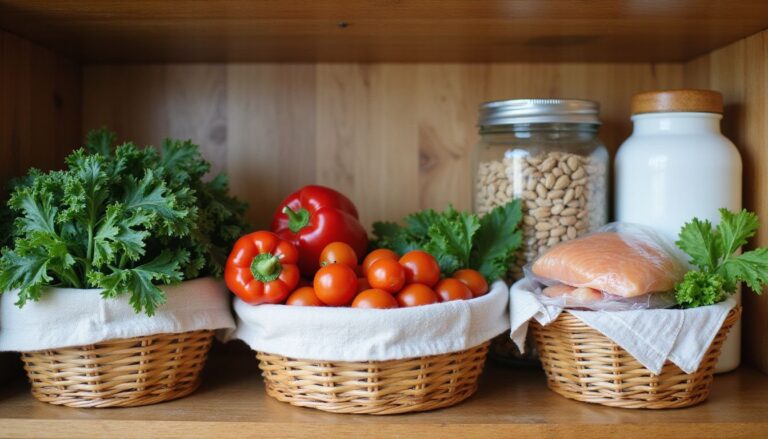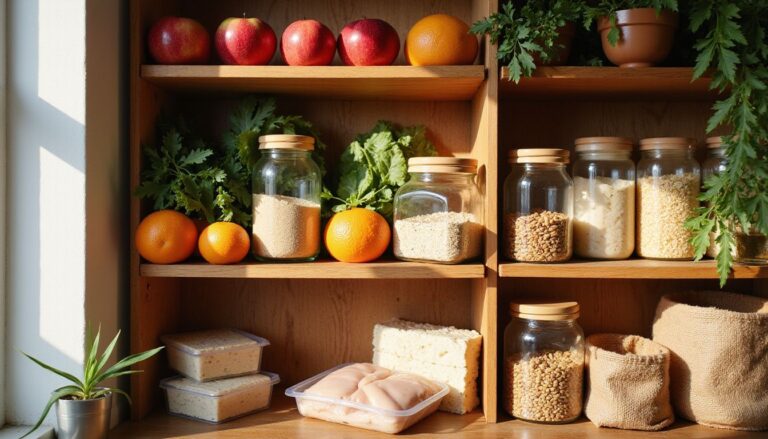Top Nutrition Counter: Calorie Calculator, Food, And Recipe Guide
Our Nutrition Assistant AI Suite will transform your body. You will lose fat, get toned, and build muscle. Gain confidence and optimal health.
Eating healthier can feel confusing. A trusted nutrition tracking app and calorie calculator turns guesswork into clear steps. With a large food database and smart tools, you can set goals, log meals, and analyze recipes in minutes.
This guide shows how to use a nutrition counter to plan meals, read labels, and build a balanced plate. You will learn to track calories, protein, carbs, and fats, then adjust recipes to fit your needs. Small changes add up fast when you have accurate numbers.
Key Takeaways
- The Top Nutrition Counter pulls nutrition facts for more than 37,000 foods and recipes from sources such as ESHA and the USDA National Nutrient Database.
- The calorie calculator uses age, weight, height, activity level, and goals to set realistic daily targets for weight management and health conditions.
- The Recipe Nutrition Analyzer lets you swap ingredients and instantly updates calories, protein, fat, carbs, fiber, and sugar per serving.
- Food logs and diaries support diabetes and heart health, and align with CDC guidance on self-monitoring habits reported in 2023.
- Support groups, blogs, podcasts, and privacy controls provide steady guidance based on evidence published through 2022–2024.
Importance of tracking nutrition for health and wellness
Tracking what you eat helps you match your intake to your needs. You can see macronutrients, which are protein, carbohydrates, and fats, and check vitamins and minerals at a glance.
Using a nutrition calculator makes label reading simpler. A food database lets you look up nutrition facts for any recipe and compare choices side by side. That is helpful for weight control and for conditions like diabetes and heart disease.
Monitoring your intake supports steady progress. Tools like the Healthy Weight Tool Kit help you set realistic milestones and watch trends over time. Community groups and symptom checkers can add accountability and ideas.
What you measure, you can manage. Clear numbers guide better habits and long-term wellness.
Introduction to the Top Nutrition Counter
A nutrition tracking app gives you accurate data, fast. The Top Nutrition Counter uses verified databases, including ESHA and the USDA, to help you make informed choices.
You can search foods from grocery brands and restaurants, then track calories, protein, fat, carbs, fiber, and sugar. Examples include almonds, salmon, quinoa, and items from chains like Starbucks and Subway.
The Recipe Nutrition Analyzer shows how ingredient swaps change a meal’s nutrient breakdown. You can personalize labels, use a barcode scanner for quick logging, and sync with wearables like Apple Watch or Fitbit for automatic updates.
Custom labels and clear goals make calorie counting and nutrient tracking simple for every meal or recipe.
Understanding Calories

Calories are energy units. Understanding them helps you plan meals that fuel your day without overshooting your goals.
Definition and role of calories in the body
Calories measure the energy you get from food and drinks. Carbohydrates and protein provide about 4 calories per gram. Fat provides about 9 calories per gram.
Your needs depend on age, height, weight, activity level, and metabolism. Body mass index, or BMI, estimates weight status using height and weight. A Food Calorie Calculator can estimate daily needs and help you log accurate totals.
Your body uses energy for breathing, digestion, thinking, and movement. Eating more than you use can lead to weight gain, while eating less than you use can lead to weight loss.
Consistent tracking supports healthy dieting and fitness. I once logged meals after workouts and noticed how serving size changed my daily totals and micronutrient intake.
How the calorie calculator can assist in weight management
A calorie calculator sets a daily target that matches your activity and body size. It uses basal metabolic rate, or BMR, which is the energy your body uses at rest, plus your movement during the day.
You can test how portion changes or ingredient swaps move your totals. The calculator includes many brand and restaurant foods for better accuracy. Comparing two recipes side by side makes smarter choices easier.
Syncing the app with a fitness tracker keeps your numbers current. Macro tracking, which means following carbs, protein, and fat, keeps your plan balanced while you cut or add calories.
Reliable data and helpful converters for cups, grams, and ounces improve your decisions for weight loss or weight gain.
Using the Calorie Calculator
The calculator turns daily eating into simple steps. It helps you estimate needs, log meals, and refine recipes for health and fitness goals.
Step-by-step guide to using the feature
- Search for a food or ingredient in the database using the keyword bar. Pick the correct match and add it.
- Open the Recipe Nutrition Calculator and click +Add Ingredient to include each component in your meal.
- Use the edit icon to adjust or remove entries. Check spelling and brand details for accuracy.
- Set how many servings the recipe makes. Serving size controls calories and nutrients per portion.
- Build a daily list by adding breakfast, lunch, dinner, snacks, and drinks. This gives a full 24-hour picture.
- If an item is not recognized, choose a close match or adjust the unit. Use the converter for grams, cups, or ounces.
- To begin a new meal, select Analyze New Recipe or Start Over. Clear the list before adding new items.
- Save or share your custom nutrition facts label. You can print or store labels for quick reuse.
Once you finish a recipe, review the nutrient breakdown. Then decide which swaps could improve it.
Importance of accurate input for accurate results
Small entry errors create big tracking gaps. Include exact brand names and use the correct units so the tool can identify each item.
The Recipe Nutrition Analyzer reads ingredient amounts as entered. If a measure looks off, use the converter and select grams, cups, or ounces.
Choose the right serving size to produce valid labels. Keeping your browser updated helps all features work well.
Careful entry helped me uncover hidden calories and plan better portions for the week.
Exploring Food Options
The Top Nutrition Counter makes it easy to compare foods and choose smarter meals. A few minutes of planning can prevent guesswork later.
Overview of popular food categories included in the guide
A balanced diet draws from many groups. The database covers thousands of items so you can mix and match.
- Grains: brown rice, quinoa, popcorn, and whole grain cereal. These provide energy and fiber for digestion.
- Vegetables: carrots, spinach, sweet potatoes, and tomatoes. These add vitamins and minerals with modest calories.
- Fruits: berries, grapefruit, avocados, and tomatoes. These add volume, flavor, and antioxidants.
- Proteins: eggs, salmon, soybeans, peanuts, flaxseed, and almonds. These support muscles and satiety.
- Dairy: low fat yogurt and milk. These supply calcium and protein for bones and growth.
- Fats: olive oil, walnuts, and other nuts. These support heart health when used in small amounts.
- Restaurants: McDonald’s, Olive Garden, Chick-fil-A, Subway, KFC, Taco Bell, Starbucks, Wendy’s, and Domino’s. You can check facts and add items to Daily Totals.
- Branded groceries: packaged foods from many companies. This helps you track meals at home and on the go.
- Each item includes a nutrition facts label. Use it to balance protein, fat, carbs, and fiber per serving.
- Filters help people manage goals, including blood sugar support and weight changes over time.
During a busy semester, seeing water and macro totals side by side helped me stay on track, even with some fast food days.
Tips for reading and understanding nutritional labels
Start with the serving size at the top of the label. Compare it to your actual portion before reading the rest of the panel.
Check calories, fats, protein, carbohydrates, fiber, and sugar. Using the Recipe Nutrition Calculator for homemade meals creates a custom label you can trust.
Test swaps such as whole grain pasta instead of regular pasta. Watch how fiber, protein, and calories change with each swap.
Focus on labels lower in added sugars and saturated fats, and higher in fiber, as suggested by USDA guidance from 2022. Use reliable sources to understand vitamins and fats rather than social media claims.
Healthy Recipes
Healthy recipes can taste great and still fit your goals. The key is balancing ingredients and portions.
Sample recipes for different dietary needs
- Low calorie breakfast: an egg white omelet with spinach and tomatoes. Use cooking spray instead of oil.
- Gluten-free lunch: a quinoa bowl with roasted veggies. Track portions in the Recipe Nutrition Calculator.
- Plant-based dinner: a chickpea and veggie stew with brown rice. Check fiber and protein per serving.
- Diabetes-friendly meal: swap white rice for barley or quinoa. Reduce added sugar in sauces.
- Heart-smart option: salmon with olive oil and steamed greens. Keep sodium and saturated fat lower.
- Portion control: scale serving sizes to match your daily target. The calculator updates instantly.
- Nut-free snack: apple slices with sunflower seed butter. Swap ingredients to manage allergies.
- Low sugar dessert: baked apples with cinnamon or yogurt with berries. Compare versions for sugar and calories.
- Macro balance: pair plant proteins with whole grains for steady energy after workouts.
- Simple swap: use Greek yogurt instead of sour cream for creamy dips and sauces.
- Save favorites: store top recipes and review weekly trends for calories, carbs, fiber, and fats.
I often replace pasta with brown rice to add fiber. The nutrition counter made that switch easy without losing flavor.
Importance of balancing macronutrients in meals
Protein, carbohydrates, and fats each play a role in energy, recovery, and fullness. The Recipe Nutrition Analyzer shows how much of each you are getting.
More protein supports muscle repair. Steady carbohydrates fuel daily activity. Fiber and lower added sugars help manage blood sugar.
Swap ingredients to hit better ratios. For example, replacing white rice with quinoa boosts protein and fiber without much extra prep.
Guidance on healthy fats and vitamins helps you plan meals that work now and later. Adjusting my protein and fat intake improved my focus during long study days.
Setting Realistic Nutrition Goals
Clear goals turn big plans into daily actions. A good calorie target and simple meal plan keep you moving forward.
How to set achievable goals based on the calculator’s results
Enter your age, height, weight, and activity level. The calorie calculator sets a daily number that fits your body and lifestyle.
Use the Recipe Analyzer to fit meals into that allowance. Set targets for protein, carbs, and fats based on your health goals.
Break large goals into weekly steps with the Healthy Weight Tool Kit. If you want to lose about 1 to 2 pounds per week, adjust portions and choose higher fiber foods.
Track weekly results and tweak as needed. That steady approach kept me consistent without feeling overwhelmed.
Summary: set specific calorie and nutrient targets, then use labels and tracking tools to make steady progress.
Importance of short-term and long-term goal setting
Short-term goals build momentum. Log meals daily, add a serving of vegetables, or swap one sugary drink for water.
Long-term goals shape lasting change. Resources like newsletters, support groups, and recipe comparisons help you adjust month after month.
Over time, refine your recipes with the calculator. I increased my monthly protein target and felt more energetic during workouts.
Review your patterns regularly. That habit keeps your plan aligned with changing needs.
Tracking Progress
Tracking shows what works and what needs a tune-up. The more consistent you are, the clearer the picture becomes.
Methods for tracking food intake and progress
- Log breakfast, lunch, dinner, snacks, and drinks with the Food Calorie Calculator.
- Save labels in your account so you can compare weeks and spot trends.
- Enter home cooking into the Recipe Nutrition Calculator to see per-serving data.
- Use a daily tally to track calories and nutrients. Patterns emerge over time.
- Join support groups to share milestones and get feedback.
- Review app insights to see what you track most and where you might improve.
- Use a find a doctor feature if you need professional guidance.
- Add brief notes about hunger, energy, and mood after meals.
- Log foods right after eating for better accuracy.
- Set reminders for meals and water, especially on busy days.
- Weigh in weekly or monthly and compare with your food logs.
These steps keep tracking simple and focused. Accurate data turns into better decisions.
Importance of evaluating and adjusting goals accordingly
Progress is rarely a straight line. Evaluate your numbers weekly or monthly, then adjust your plan.
Use the recipe comparison tool or the Healthy Weight Tool Kit to find smarter swaps. I changed my dinner portions after reviewing my logs, and my energy improved in a few days.
Update goals as your lifestyle changes. Articles and newsletters in the app can guide these updates.
Good data keeps targets within reach. Next, clear up a few common myths that can slow progress.
Dispelling Nutrition Myths
False claims can distract you from what works. Facts and simple habits deliver better results.
Debunking common myths related to dieting and calorie counting
Cutting all fat does not speed weight loss. Healthy fats from nuts, avocados, and olive oil support cell health and vitamin absorption.
The Top Nutrition Counter shows how fats fit into your calorie plan. Evidence-based tools in the Healthy Weight Tool Kit help filter hype from facts.
Calorie counting is not starving yourself or banning food groups. A calculator sets a target that matches your needs. The World Health Organization advises careful use of non-sugar sweeteners, especially during pregnancy.
Balanced macronutrients support steady energy. Careful label reading also helps you spot added sugars and sweeteners in common foods.
Encouraging a balanced approach to nutrition
A balanced approach is easier to keep long term. Use the counter to compare ingredients and portion sizes before you plate your meal.
People who keep a food diary are more likely to meet their goals, according to CDC reporting in 2023. Labels guide portion sizes and nutrient choices at each meal.
Support groups offer community and ideas. I stayed consistent by rotating meals with whole grains, lean proteins, fruits, and vegetables.
Recipe analysis gives quick feedback so you can adjust on the spot. Education resources on nutrients and hydration keep your plan grounded in facts.
The Role of Hydration
Water powers digestion, circulation, and energy. Think of it as a quiet helper that keeps every system running well.
Importance of adequate water intake for health and digestion
Water moves food through the digestive tract and supports nutrient absorption. Water-rich foods like cucumber, celery, and grapefruit also help you meet fluid goals.
The nutrition counter includes beverages and hydrating foods, so your fluid intake shows up along with your meals. Reading drink labels helps you avoid extra sugar and calories.
Tracking both food and drink kept me aware of my hydration all day. Enough fluid supports metabolism and may reduce headaches and constipation.
Many adults aim for about eight 8-ounce glasses of fluids daily for healthy digestion1. Apps can help you prevent dehydration and fatigue.
1. Mayo Clinic Staff. 2022. Water: How much should you drink every day? Mayo Foundation for Medical Education and Research.
Tips for staying hydrated throughout the day
- Carry a refillable bottle to prompt regular sips at work and on the go.
- Track beverages in the Top Nutrition Counter along with food.
- Choose water-rich foods like cucumbers, strawberries, and watermelon.
- Schedule small sips across the day, not just when you feel thirsty.
- Include options like brewed tea or infused water for variety.
- Limit sugary drinks that add calories without helping hydration.
- Check nutrition facts on beverages for added sugars and sodium.
- Use Health & Balance resources for safe beverage choices.
- Spread intake from morning to evening for better absorption.
- Set hourly reminders. This habit improved my focus and energy.
Conclusion
Strong habits grow from clear numbers and steady practice. A reliable calorie calculator and recipe analyzer help you act with confidence each day.
Recap of the benefits of using the Top Nutrition Counter
You get nutrition data for more than 37,000 items in one place. The Top Nutrition Counter includes a calorie calculator, recipe analysis, and the Healthy Weight Tool Kit for planning and progress checks.
These tools support many goals, from weight control to managing blood sugar. You can log foods, drinks, and recipes, and set privacy preferences. Education resources, podcasts, and groups help you stay informed and motivated.
The symptom checker helped me notice patterns that affected my energy. If you live with a medical condition, seek advice from a licensed clinician or a registered dietitian for a personalized plan.
Encouragement to take charge of one’s nutrition for a healthier lifestyle
Taking charge starts with one meal and one honest log. The Top Nutrition Counter gives you the numbers, the labels, and the steps to keep going.
Set small goals, review progress, then adjust. Consistent tracking, simple swaps, and clear targets will move you closer to the healthy life you want.
Start today with the calorie calculator and your next meal. Your plan can be simple, practical, and sustainable.
FAQs
1. How does a nutrition counter help track calories and nutrients?
A nutrition counter uses food data to calculate the calorie content and nutrient values of meals. Users enter foods or recipes, then receive detailed information about energy, protein, carbohydrates, fats, vitamins, and minerals. Research shows that tracking intake with such tools can support healthier eating habits and weight management (Harvard T.H. Chan School of Public Health).
2. What features should I look for in a top calorie calculator?
Look for calculators that provide accurate food databases from trusted sources like the USDA FoodData Central. The best ones allow you to log custom recipes, adjust portion sizes, and view daily summaries of calories along with macronutrients.
3. Can recipe guides improve my diet quality?
Recipe guides offer step-by-step instructions using whole ingredients while displaying nutritional breakdowns per serving. Studies indicate that following structured meal plans can increase vegetable intake and reduce added sugars (Journal of Nutrition Education and Behavior). Using these guides helps users make informed choices at each meal.
4. Is it possible to use personal experience when choosing foods with a nutrition tracker?
Yes; many people find success by logging their own meals over time then reviewing patterns in their eating habits through app reports or charts. For example, after tracking lunches for two weeks I noticed higher sodium levels on days I ate out compared to home-cooked options.
Summary: Nutrition counters combine evidence-based data with practical tools such as calorie calculators and recipe guides; they empower users to monitor dietary intake accurately while supporting better health decisions based on both scientific research and personal experience.







